Archives
15 May, 2018
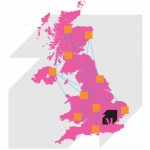
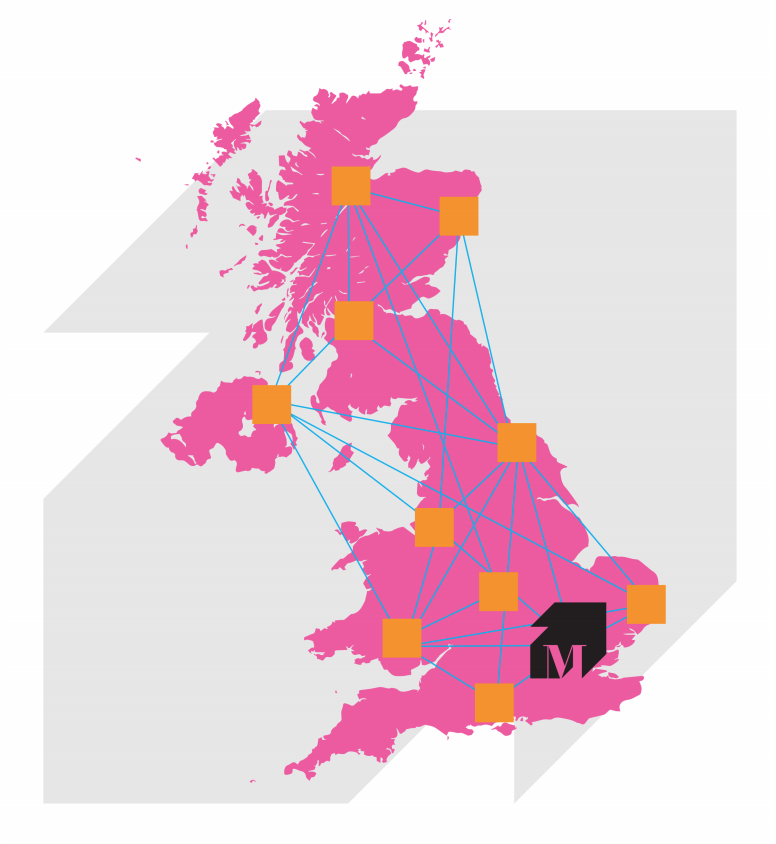
From November 2016 to November 2017, we coordinated the pilot year of the Migration Museums Network, generously funded by Arts Council England and Paul Hamlyn Foundation.
This network pilot aimed to increase and improve outputs associated with migration and related themes in museums and galleries across the UK. Various activities met these aims: a widespread online survey about migration themes in our sector was completed by 119 respondents from a range of institutions across the UK. We delivered a report, co-authored by Dr Cathy Ross and Emma Shapiro on the status of migration themes across the sector; updating previous research from 2009 with lots of new information and highlights. We also held two events in the autumn of 2017, focused on sharing best practice, highlighting case studies and facilitating partnerships across the sector. One was at the British Museum in London with 80 delegates; the other was at the Discovery Museum in Newcastle with 40 delegates. Thanks to all those who participated in the events.
Evaluation of the pilot was positive, with participants expressing strong demand for an information-sharing network on migration themes and giving positive feedback on the two events held to date. The overwhelming majority of survey respondents and delegates expressed a clear desire to be part of a Migration Museums Network, and to share contact and project details, via Network events, and online.
For more information and to read the report, survey and evaluation findings in full, please click on the links below:
Download and read the Migration Museums Network 2017 Evaluation report
Download and read the report on the Migration Museums Network survey results 2017
Download and read the Museums and Migration 2009-17 report
To find out more about the pilot of the Migration Museums Network and explore possible next steps for this network, please contact our Head of Learning and Partnerships Emily Miller: Emily@migrationmuseum.org

24 October, 2017
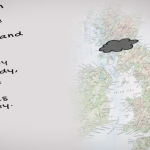
In the third of our series reflecting on the experience of running workshops with young people and schoolchildren, Sarah Crafter (The Open University) and Humera Iqbal (University College London) talk about a project that has as its focus young people and children who act as interpreters for their parents and families – and how this focus can enhance the empathetic understanding of pupils (the vast majority) who are not migrants themselves.
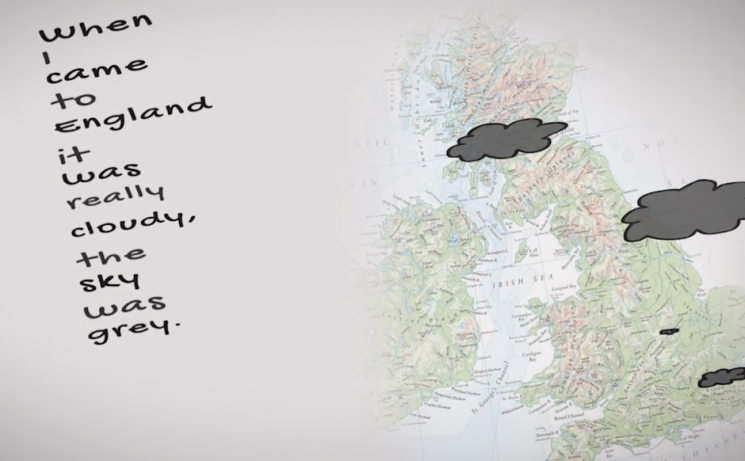
Animation and image by Alan Fentiman: http://bit.ly/2aVfHYw
‘When I was small and I moved in Milan, I used to live with my parents and uncles. I have really good memories with them until the age of 12. Unfortunately, I had to move to the UK, and they couldn’t come. This event changed me and the way I act.’ Safi, aged 15, (Bangladesh, Italy, UK)
Safi, aged 15, moved to Britain three years ago from Italy, having previously lived in Bangladesh. His childhood had been full of instances of resettlement. When young people, like Safi, migrate to a new country, they can often be left with a sense of loss: for people left behind and places they loved. At the same time, they can face new challenges in their new setting; getting to know new people, learning the language, culture, systems and structures in the new country.
We explored some of these themes at the workshop we ran in 2016 for the Migration Museum Project with a group of 65 local schoolchildren at their exhibition Call Me by My Name: Stories from Calais and Beyond. For quite some time we have been working with children and young people who have migrated with their families to a new setting in which they act as child language brokers – children and young people who interpret and translate for family and friends who can’t speak English. Over the years we have learnt that young people translate across lots of different situations and places like doctor’s surgeries, schools, banks, shops and workplaces. Sometimes they really enjoy being a young translator and take great pride in being able to help their families and friends. In other instances the conversations are difficult and people are not always very sympathetic. Many of the young people we speak to tell us, just as Safi did, how difficult it was to arrive in a new country and not be able to understand what people were saying. This sense of change and loss was also explored in the Call Me By My Name exhibition in relation to refugees, and we were able to identify many similarities between the exhibition and our research.
We built on some of these themes in the workshop. We asked the pupils to think about what it feels like to migrate, to be in a new place, to go into the unknown and to learn to communicate when there is no shared language. We started by showing a short animation from our research which features the voices of young people speaking about arriving in a new place and translating.
After watching the film, the young people gathered into groups to talk about some of the main themes that had arisen. This was quite a difficult task for some people, especially if they hadn’t experienced or thought about what it might mean to be a young translator or to migrate to a new country.
Yet, in truth, most of us can pinpoint a situation or feeling of being ‘out of place’ or alone, or unable to say what is in our minds. We wanted everyone to be able to capture that feeling and, to do that, we asked the pupils to put together a timeline map of their own experiences (working with timelines being something we have done in our research). We showed a timeline map made by a teenager called Kitty, who had migrated from Hong Kong to the UK with her family. It captured many markers of upheaval as well as instances of emotional change in different stages of Kitty’s life.
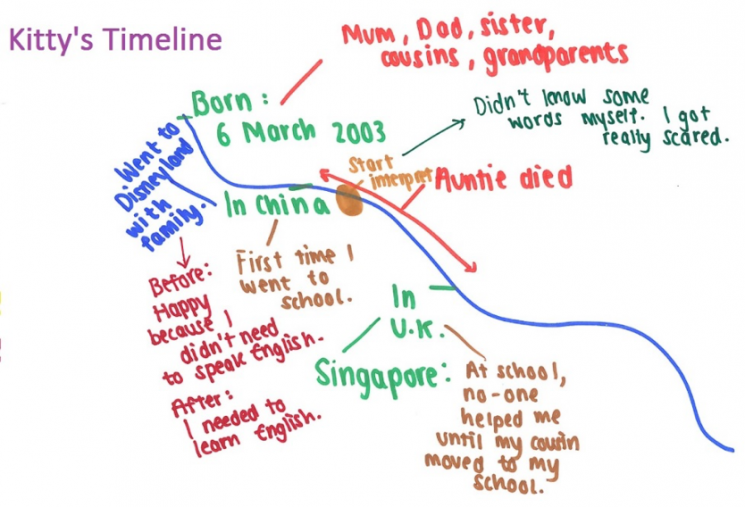
Using Kitty’s narrative as inspiration, the workshop pupils were asked to draw their own timeline, starting with the places they had lived or the places they had moved to (a house, a street, a country). The pupils then added people in their ‘migration timeline’ to get a sense of those who are always with us, those who come into our lives and those who fade out. Languages learnt and spoken were added. The pupils were encouraged to describe any ‘firsts’ they had experienced, such as the first time riding a bike, trying a particular food, reading something that made them cry.
This workshop was useful for the pupils because it enabled those who had never migrated to a new country, or learnt a new language, to gain a greater depth of empathy and understanding about how this must feel. In loading memories of newness, change, experience and important relationships, the pupils were encouraged to explore what their own feelings might be in moving to a new country and learning a new language. Our workshop also helped those pupils who had migrated, and who did speak a second language, to talk freely about their experience with their friends. We were impressed with how bravely they spoke to us, and their friends, about what that felt like for them. Teachers might also use similar exercises or prompts within school during citizenship and personal health and healthcare lessons, to explore issues of diversity.
You can find more information about our project here.
Dr Sarah Crafter is a senior lecturer in the Department of Psychology at the Open University in the UK. She has a PhD in Cultural Psychology and Human Development and is interested in cultural identity development and ‘non-normative’ childhoods. Her work with child language brokers grew out of broader interest in the constructions or representations of childhood in culturally diverse settings. Dr Humera Iqbal is a lecturer in psychology at the Department of Social Science at University College London. She is interested in identity and the migration experiences of families and young people, in particular how they engage with institutions in new settings. She is also interested in mental health and wellbeing in young people, particularly those from minority groups. Her research uses mixed methods as well as arts- and film-based methods.
18 October, 2017
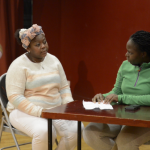
In the second of three blogs on holding workshops with school pupils on the issues of migration, Umut Erel and Elizabeth Newcombe discuss an attempt to introduce pupils to the complexities of the language and the policy issues surrounding immigration, at a time of great global inequality and economic recession.
When holding a workshop for a school from Sussex at the Migration Museum Project’s Call Me By My Name exhibition in July 2017, it was striking to see school pupils becoming passionately engaged with issues of migration. The group of 15 pupils and their teachers arrived on one of the hottest days of the year, having already spent time wandering through London. Emily Miller, MMP’s head of learning and partnerships, started the workshop with an interactive game, using questions and movement in the space of the museum to break the ice and find out how everyone relates to migration. Some of the questions she asked were:
- Do you know someone who has migrated?
- Do you speak more than one language?
- Has anyone in your family migrated?
If our answer to these questions was ‘yes’, we had to take a step forward; if the answer was ‘no’, we were asked to take a step backwards. Soon most of us were concentrated in a tight circle in the middle of the room, and it had become clear that there was a lot of experience of migration, whether personal or indirect.

Drawing by Laura Sorvala.
The workshop then moved on to look at some of the key terms in the migration debate. A young refugee told of his experiences of migration, finding his way around life in the UK and how he now works in arts and education organisations in which he initiates dialogues on the experiences of refugees and migrants. All of us were stunned to hear of the difficulties he had overcome on his journey to the UK in the early 2000s. Some of the pupils shared their personal experiences of the country he came from and the countries he had passed through, which gave the encounter added poignancy.
After this informative and emotionally charged part of the workshop, we changed gears slightly and introduced a more academic take on the issues. Starting with an interactive exercise on global inequalities of income, we began to question the term migrant, pointing out that, when we use the terms ‘migrant’ and ‘refugee’, this does not refer to a legal figure or a dataset, but to a political figure. We discussed how British people living abroad almost always think of themselves as ‘expats’ not ‘migrants’, while Black Asian and Minority Ethnic (BAME) people who were born and have lived all their lives in the UK are often called ‘second generation migrants’. So, the decision about who counts as a migrant is often framed by assumptions about race, class and nationality.
When discussing migration, we often hear about the need to protect the welfare state from outsiders, but how can we understand the welfare state against the backdrop of global inequalities? We are living at a time of the highest level of global inequality in human history, when the wealth of 67 people is the same as the combined total of the world’s 3.5 billion poorest people, and the poorest 50 per cent of the world have 6.6 per cent of total global income. There are issues with the methodology of these estimates, but it cannot be denied that the world has changed from the 19th century. Today, for most people in the world, what is key to your life chances is the country you live in. The fear for those living in wealthier states is that there are a lot of people who are hard up in the world and that, if you don’t have much, you need to hold on to it.
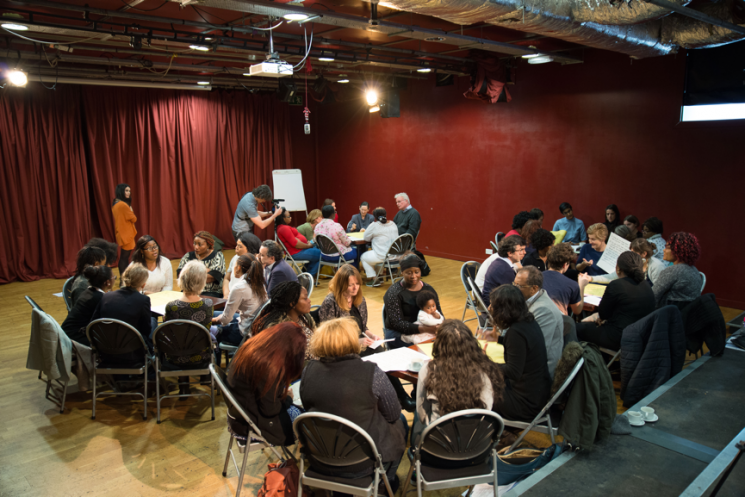
Photo of the PASAR project’s ‘From Margins to Centre Stage’ workshop, February 2017 © Marcia Chandra.
Migrant families’ exclusion from the welfare state was a topic in another research project – Participation Arts and Social Action in Research (PASAR) – we are currently running with our colleagues Erene Kaptani (Open University), Maggie O’Neill (University of York) and Tracey Reynolds (University of Greenwich). The PASAR project conducted participatory research with migrant mothers affected by the policy No Recourse to Public Funding (NRPF), which means migrants who are subject to immigration control are not allowed to access benefits, tax credits or housing assistance. This policy affects both migrants who have the right to remain in the UK and those who are undocumented. The policy pushes these migrant families – many of whom include young children, who are among the most vulnerable people – to the margins of society through poverty and racism. In a workshop with policy makers, practitioners and activists, we worked with a group of migrant mothers affected by NRPF to enable their collective voice to be heard. To do so, we showed a short theatre piece developed through the research.
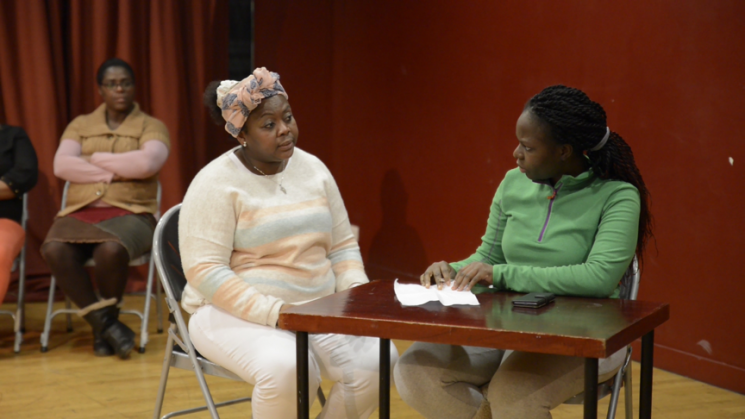
Photo from PASAR project theatre scene © Marcia Chandra.
At the schools’ workshop, we watched a short scene from this theatre piece about Elaine’s experience. Elaine had been working for many years for a large supermarket. She needed to take time off every two weeks to sign into the Immigration Reporting Centre, a requirement of the Home Office. Her manager used his knowledge of her vulnerability to bully her and change her onto an unfavourable night shift, even though she had just had a baby. Her union representative’s response was that as an immigrant she should be glad to have a job. She also experienced stigmatisation by fellow workers, who saw her as an ‘illegal’ immigrant. Eventually, she lost her job – unable to pay rent, Elaine, her husband and six-year-old son have for four years now been living in the houses of friends and acquaintances, surviving on their monetary support.
This example shows how racism, anti-immigration policies and austerity intersect. An increasingly hostile climate to immigration has made it more difficult for migrants to find formal and informal employment. As a consequence of increasingly stringent migration regulations, particularly since 2012, more and more migrant families are subject to migration control, prevented from accessing public funds and rendered unable to economically support themselves (Price and Spencer, 2015). In a situation of crisis – through the loss of jobs or accommodation, relationship breakdown or health problems – they cannot draw on the relative safety net of the welfare state to help them overcome these points of crisis and are pushed more and more to the margins of society.
Having watched a short video clip of these theatre scenes with the school pupils, we had an interesting discussion about some of the issues raised by Elaine’s story:
- How can labels such as ‘illegal migrant’ be misleading and stigmatising?
- Why are some people, and not others, allowed to draw on welfare services?
- Should contributions through work be the criterion for deciding whether migrants can participate in the welfare state?
- Should there be other criteria for inclusion into welfare, based on colonial and postcolonial ties?
- Should there be criteria based on shared humanity?
It is hard to summarise the workshop, as it was rich and varied, but it seems to me that this variety of modes of engagement (personal testimony, interactive activities, and audio-visual material and information) has been fruitful in raising many questions, showing the complexity of issues of migration and welfare, and linking conceptual discussions to personal experiences of migration, which are often far richer than those portrayed in public debate. While teachers challenged us as academics to present information in accessible ways, especially for pupils who are still learning English, their feedback was heartening: ‘Our students learnt a lot from the experience both about migration at the human level but also the bigger picture of why these issues are so pressing for the UK at the present time. A great day well spent!’
Reference
Price, Jonathan, and Spencer, Sarah (2015) Safeguarding Children from Destitution: Local Authority Responses to Families with ‘No Recourse to Public Funding’. Oxford: COMPAS.
Umut Erel is Senior Lecturer in Sociology at the Open University. She is Principal Investigator of PASAR, an ESRC-funded research project investigating the opportunities and challenges of using participatory theatre and walking methods for social research.
Emma Newcombe is the Head of External Relations for COMPAS and the Global Exchange on Migration and Diversity. She oversees all COMPAS’s communications work, and also supports the development of the ESRC Urban Transformations project. She has an MA in Migration Studies from the University of Sussex and a BSc in Social Policy from the University of Bristol.
21 October, 2016
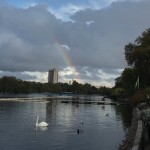
We went on a walk last Sunday, along with about 130 others.
It started in the cold, grey and wet, at a time when many of us would still be, if not in bed, certainly doing nothing much more energetic than turning the pages of a Sunday paper and slurping coffee. It ended in glorious early-evening light, with a rainbow over the Serpentine and, if not actual gold at the end of the rainbow, then the next best thing – cakes and prosecco.
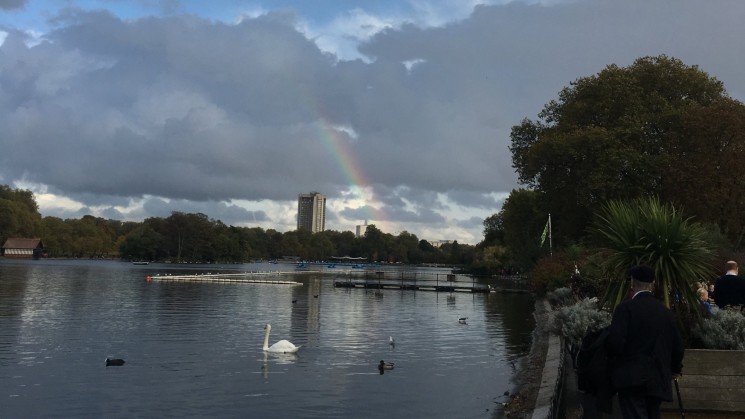
Somewhere over the rainbow … Looking east from the Lido café in Hyde Park, the end-point of our Imprints walk. © Faiza Mahmood
It started in Greenwich, where so many migrant stories have started in the past – George I prominently among them, borne to his disembarkation at the Old Royal Naval College aboard the ship Peregrine, but also, though much less regally, Ignatius Sancho, born on a slave ship and later a lobbyist for the abolition of the slave trade. It ended in Hyde Park, just short of the Albert Memorial, flamboyant statue to one of the most-loved migrants of the nineteenth century and the inspiration for the cluster of museums and institutions – Albertopolis – that now draw so many visitors to our capital.
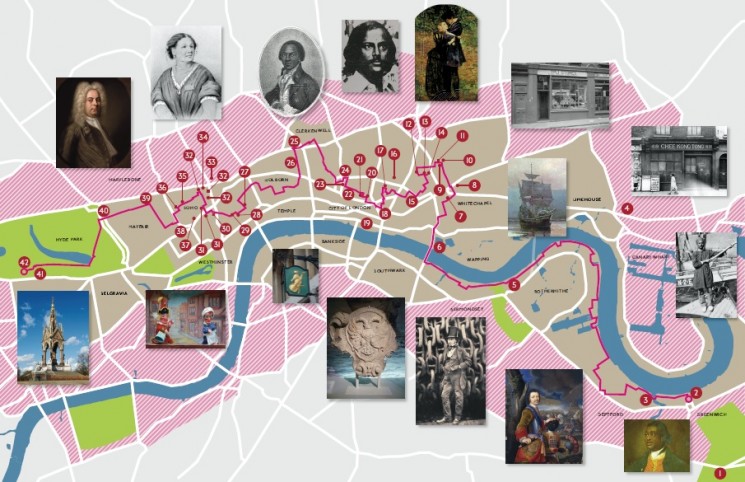
The outline of the route the Imprints walk took through London. © Brandingbygarden
Not all migrants migrate from east to west of the city, of course, but it’s a useful hook to hang an event of this kind on. It’s certainly a long walk, that walk from arrival to establishment, and not all migrants make it with equal success, happiness and good fortune. And it was a long walk, literally, on Sunday, a full 15 miles and counting, which not all participants made with equal success, happiness and comfort of foot. But the overwhelming majority of those who started the walk completed it, and there was a sense of euphoric satisfaction in Hyde Park at the end of the day that may have had something to do with the prosecco on offer, or possibly with the sheer relief of the walk now being at an end – but which was mostly down to the sense of fulfilment and enjoyment of a day spent in good company, learning something about the myriad migration stories that make up the history of London, and of the multiple layers that make each street and region a palimpsest of the migratory experience: whether it’s the Brick Lane Jamme Masjid mosque, in a building that had previously been a synagogue and was, before that, a Huguenot chapel; or the building in Old Jewry, now housing the visa office for the People’s Republic of China but almost eight hundred years previously the site of the first synagogue in this country; or 25 Brook Street, home to George Frideric Handel in the 1700s and the more raucous stomping ground of Jimi Hendrix in the 1960s.
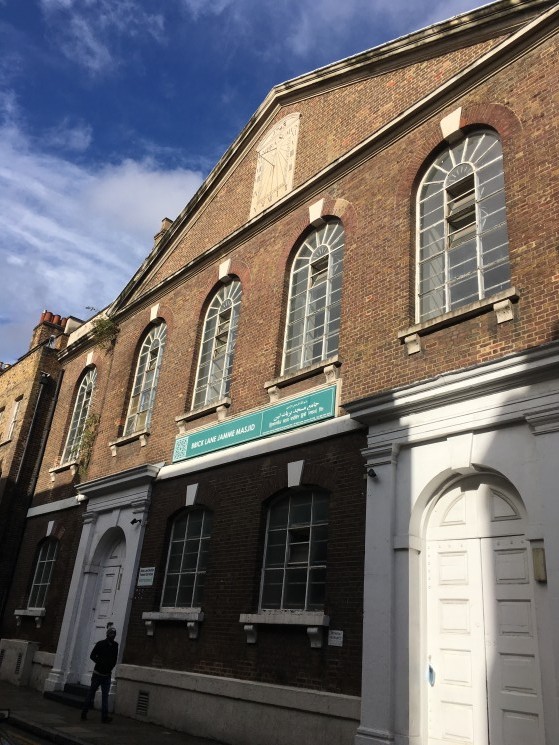
The Jamme Masjid mosque in Brick Lane – previously a synagogue and, before that, a Huguenot chapel. Spectacular minaret sadly not shown. © Aditi Anand
Divided into groups of 10 to 15, each led by an incredibly well-versed volunteer guide and supported by one of our magnificent volunteers, we walked along the south bank of the Thames to Tower Bridge, meandered through the East End, Brick Lane and Spitalfields, wandered through empty and storm-soaked streets in the City, rising again into Clerkenwell and Holborn – passing through the world of clockmakers, jewellers, lawyers and artists, before moving westwards through Covent Garden, Soho, Kensington and Mayfair. In Postman’s Park, Bill Bingham (our very own Ian McKellen) appeared out of nowhere, surprising us with a rendition of Shakespeare’s Thomas More speech (‘Grant them removed, and grant that this your noise / Hath chid down all the majesty of England … ’), delivered (in theory) in the early 1600s to quell riotous discontent at the arrival of the Huguenots. We stopped along the way to hear the story behind particular buildings, or about individuals who had lived in that area, or whole movements of people; and in-between we talked to each other about our own stories, about plans for the Migration Museum Project, about how our country would change in the wake of the recent referendum decisions.
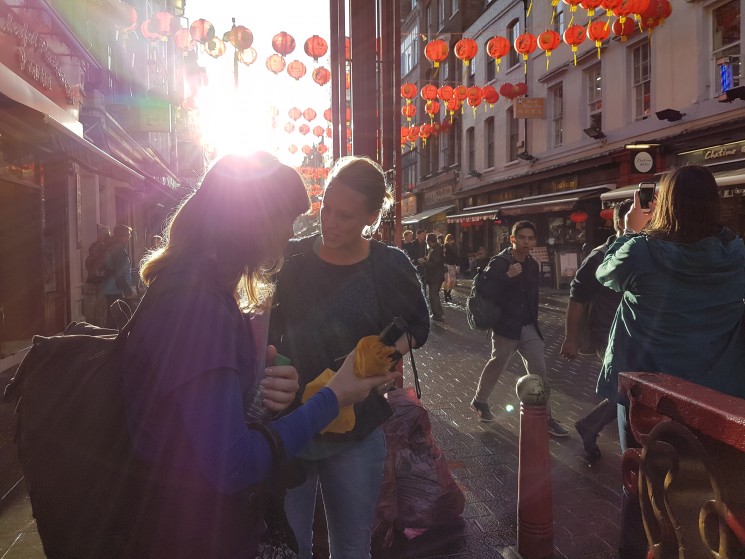
Emily Miller, the MMP’s education manager, in Chinatown with Isabel Morrison. © David Wigram
We liked it so much we are already planning to do it again next year – at least once more in full length, and maybe on a number of other occasions, in a shorter form. And already we’re thinking, if this works so well in London, why wouldn’t it work just as well in any number of other cities: Newcastle, Manchester, Glasgow, Liverpool, Belfast, Bristol, Leicester? Get in touch with us if you want to help us plan how to extend it.
Oh, and we raised hugely important funds for the MMP’s work, too. Our target was to raise £20,000 to enable us to continue delivering exhibitions, events and education work in schools as we build the case for a permanent Migration Museum for Britain. At the time of writing, we are still a little short of our target – the equivalent of finding ourselves in Regent Street, when we need to be in Hyde Park. If you would like to help us reach our target or destination, please go to our MyDonate page.
And, just in case you can’t quite take our word for it, have a look at what some of the walkers had to say about the experience:
Epic day with informed guides – great fun despite the rain!
What a fab day! Like walking through a spread of London’s amazing history!
A wonderful way to explore London and discover how migration is a fundamental part of the city’s identity.
Amazing experience, informative and enlightening. Highly recommend it
I enjoyed seeing so much of London in one go, and learning about all the little histories and significances that would have gone unknown otherwise.
I loved the content and it’s great to have the map as a momento. Lots of highlights that I have been boring my nearest and dearest with: Mayflower pub selling US stamps – Rotherhithe tunnel used to have shops! – De Hems pub history … and of course the wonderful performance in Postman’s Park, a speech which I didn’t know and now love.
Very interesting, and I learned lots! Like the fact that it was easier to be black than Catholic in Tudor England! It made me think about things in a totally new way – I hadn’t thought of Paul Reuter as a German immigrant to London before!
We went on a walk last Sunday. It was a huge success, raising funds and fun in equal measure. Why don’t you come on the next one we organise?
The first Imprints: London Migration Walk took place on Sunday 16 October 2016. Huge thanks to our team of volunteer guides, all of whom were mines of information, wit and inspiration – and to the volunteers who supported them. Without you, this project would be struggling! But the biggest thank you goes to the 130 participants who so good-naturedly and energetically gave up their Sunday to support us on the walk, and did so without complaint, even when the skies emptied their load on us in the early afternoon. Thank you, thank you, thank you. Here’s to the next one!
















